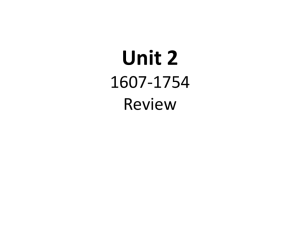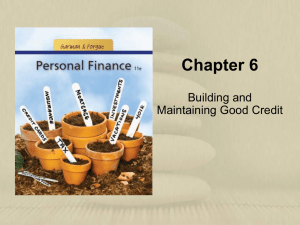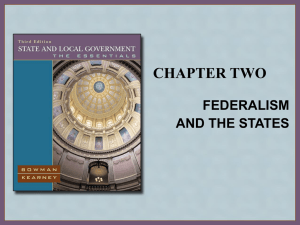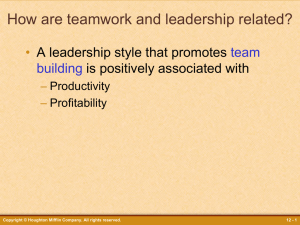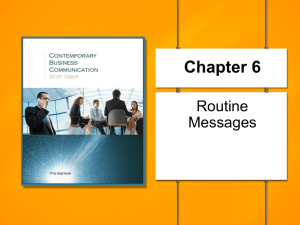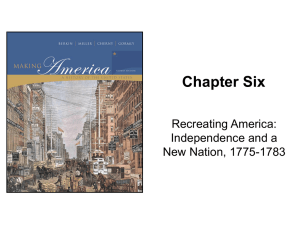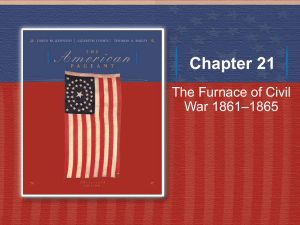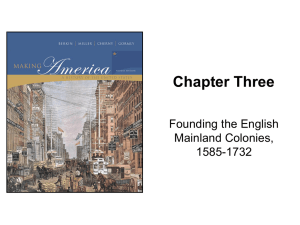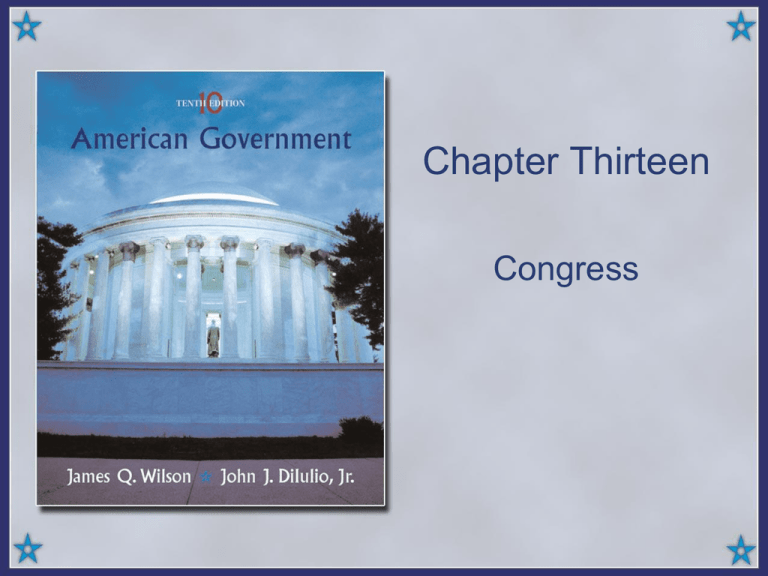
Chapter Thirteen
Congress
CHAPTER 13
Article I
Copyright © Houghton Mifflin Company. All rights reserved.
13 | 2
Congress
• The intent of the Framers:
– To oppose the concentration of power in a
single institution
– To balance large and small states
• Bicameralism
• House of Representatives and Senate
– To avoid the tyranny of the majority, or
populism
• They expected Congress to be the
dominant institution
Copyright © Houghton Mifflin Company. All rights reserved.
13 | 3
Section 1:
This section provides for a BICAMERAL
legislature, consisting of a
• HOUSE OF REPRESENTATIVES and
SENATE.
Copyright © Houghton Mifflin Company. All rights reserved.
13 | 4
What are the terms of office of the House
of Representatives?
• 2 years
What are the terms of Senators?
• 6 years
Copyright © Houghton Mifflin Company. All rights reserved.
13 | 5
Section 2:
Hilary, age 32, wants to run for office in the
House of Representatives. Does the
Constitution permit her to do so?
• YES THE MINIMUM AGE IS 25
Copyright © Houghton Mifflin Company. All rights reserved.
13 | 6
In 1790, the state of Rhode Island had
approximately 60,000 people. How many
Representatives would Rhode Island have
in the House according to the formula
prescribed by the Constitution?
• 2 REPRESENTATIVES
Copyright © Houghton Mifflin Company. All rights reserved.
13 | 7
We see that taxation based on population
was removed by Amendment XVI. Rather
than direct taxes being based on
population, this amendment allows the
national government to tax INCOME.
Copyright © Houghton Mifflin Company. All rights reserved.
13 | 8
How is the system of checks and balances
represented in the “sole power” granted to
the House of Representatives?
• SOLE POWER OF IMPEACHMENT OF
EXECUTIVE AND JUDICIAL—CAN
REMOVE FOR CAUSE
• IMPEACHMENT IS A TRIAL:
PROSECUTOR, JUDGE, AND JURY
Copyright © Houghton Mifflin Company. All rights reserved.
13 | 9
Section 3:
How can we see that representation in the
Senate is equal among the states?
• 2 SENATORS PER STATE; ONE VOTE
EACH
Copyright © Houghton Mifflin Company. All rights reserved.
13 | 10
Why does the Constitution break the Senate
into three classes?
• ROTATING ELECTIONS TO PREVENT
REVOLUTIONARY CHANGE
Copyright © Houghton Mifflin Company. All rights reserved.
13 | 11
Jeff, a 37 year old tax attorney from New
York, wishes to run for the Senate. He
currently lives in Tampa, Florida. Is he
allowed to run for Senator for New York?
Why or why not?
• NO, MUST BE AN INHABITANT OF
STATE
Copyright © Houghton Mifflin Company. All rights reserved.
13 | 12
The Senate is voting for President Obama’s
funding request for the bank bailout. There
is an even split among the 100 senators.
Who casts the final vote?
• THE VICE PRESIDENT AS PRESIDENT
OF THE SENATE
Copyright © Houghton Mifflin Company. All rights reserved.
13 | 13
As a further “check,” what “sole power” is the
Senate granted? Why do you think this is
the case?
• SIT AS JURY ON IMPEACHMENT
CASES; 2/3 NECESSARY TO REMOVE—
CAN ONLY PUNISH BY REMOVAL
FROM OFFICE, BUT IMPEACHED
OFFICER MAY STILL BE LIABLE FOR
CRIMES OR CIVIL ACTIONS.
• NO DECISIONS OF PEOPLE WITHOUT
CONSENT OF STATES
Copyright © Houghton Mifflin Company. All rights reserved.
13 | 14
Section 5:
Why does the Constitution require that each
house publish a journal of its proceedings
that is to include the voting record of each
of its members?
• TO INFORM PUBLIC, HOLD
REPRESENTATIVES ACCOUNTABLE
TO PEOPLE
Copyright © Houghton Mifflin Company. All rights reserved.
13 | 15
Section 6:
Do members of Congress receive a salary?
If so, who pays?
• YES, THE US TREASURY -- $6 A DAY,
NOW $174,000 A YEAR WITH $400,000
ALLOWANCES
• ORIGINALLY $6 A DAY
Copyright © Houghton Mifflin Company. All rights reserved.
13 | 16
Section 7:
All tax bills must originate in the HOUSE
Why do you think that this is the case?
• REPRESENTATIVE OF THE PEOPLE
Copyright © Houghton Mifflin Company. All rights reserved.
13 | 17
The House of Representatives proposes a
bill that would provide all Americans with
health insurance. The Senate approves
the bill and passes it to the President. The
President disagrees with the bill and vetoes
it. What must occur in order for the health
insurance bill to become a law?
• OVERRIDE WITH 2/3DS OF BOTH
HOUSES
Copyright © Houghton Mifflin Company. All rights reserved.
13 | 18
Section 8:
What are three powers granted to Congress
that helped to stabilize the nation’s
economy?
• TAX
• BORROW MONEY
• REGULATE COMMERCE
• COIN MONEY
• GIVE PATENTS
Copyright © Houghton Mifflin Company. All rights reserved.
13 | 19
What are three powers granted to Congress
that provided for the “common defense” of
the nation?
• DEFINE AND PUNISH CRIMES ON HIGH
SEAS
• DECLARE WAR
• MAINTAIN NAVY AND ARMY
• CALL UP MILITIA
Copyright © Houghton Mifflin Company. All rights reserved.
13 | 20
What clause allows Congress to go beyond
its enumerated powers?
• NECESSARY AND PROPER CLAUSE
Copyright © Houghton Mifflin Company. All rights reserved.
13 | 21
Section 9:
How is Section 9 different from Section 8?
• RESTRICTIONS ON LEGISLATURE
Copyright © Houghton Mifflin Company. All rights reserved.
13 | 22
What are four powers denied to Congress?
• RESTRICT SLAVE TRADE TIL 1808
• SUSPEND HABEAS CORPUS UNLESS
PUBLIC SAFETY
• NO ATTAINDER (GROUP GUILTY
WITHOUT TRIAL)
• NO EX POST FACTO LAW
• NO INTERSTATE TARIFFS
• NO PREFERENTIAL TREATMENT TO
ANY STATE
• NO TITLES OF NOBILITY
Copyright © Houghton Mifflin Company. All rights reserved.
13 | 23
Section 10:
It can be said that federalism is most
noticeable in Article I, Section 10. Explain.
• EXPLICIT LIMITATIONS OF THE
POWERS OF THE STATES
Copyright © Houghton Mifflin Company. All rights reserved.
13 | 24
The states of California and New York have
decided to protest U.S. involvement in
Afghanistan. They create the “Alliance for
Afghan Liberation,” refusing to
acknowledge the power of the national
government so long as President Obama
insists on keeping troops in Iraq. Do
California and New York have the right to
create such an alliance? Explain.
• NO, CANNOT ENTER INTO
AGREEMENT WITH ANOTHER STATE
OR FOREIGN POWER
Copyright © Houghton Mifflin Company. All rights reserved.
13 | 25
Differences between
Parliament and Congress
Copyright © Houghton Mifflin Company. All rights reserved.
13 | 26
Differences between Parliament and Congress
http://www.youtube.com/v/5xUy2inkGHQ
Copyright © Houghton Mifflin Company. All rights reserved.
13 | 27
•Parliamentary candidates are
selected by their party
•Become a candidate by
persuading your party to place
your name on ballot
•Voters choose between
national parties, not candidates
•Members of Parliament select
Chief Executive
•Party members vote together
on most issues
•Re-nomination depends on
remaining loyal to party
•Principal work is debate over
national issues
•Individual Members have very
little actual power, very little
pay or staff resources
Copyright © Houghton Mifflin Company. All rights reserved.
Parliament
13 | 28
Congress
Copyright © Houghton Mifflin Company. All rights reserved.
•Vote is for the candidate, not
the party
•Members primarily represent
districts or states, not parties.
•Party discipline is limited
•Members do not choose the
chief executive—voters elect
president
•Power is decentralized and
members are independent
•Members’ principal work is
representation, negotiation, and
passing laws
•Members have a great deal of
power, high pay and significant
staff resources
13 | 29
What else do you notice?
Copyright © Houghton Mifflin Company. All rights reserved.
13 | 30
Congress
• The intent of the Framers:
– To oppose the concentration of power in a
single institution; separation of powers
– To balance large and small states
• Bicameralism
• House of Representatives and Senate
– To avoid the tyranny of the majority, or
populism
– To encourage compromise
• They expected Congress to be the
dominant institution in the government
Copyright © Houghton Mifflin Company. All rights reserved.
13 | 31
Who is in Congress?
Copyright © Houghton Mifflin Company. All rights reserved.
13 | 32
Table 13.1: Blacks, Hispanics, and
Women in Congress, 1971-2002
Copyright © Houghton Mifflin Company. All rights reserved.
13 | 33
WIKIPEDIA!*
http://en.wikipedia.org/wiki/Members_of_the_111th_United_S
tates_Congress
•How many women are currently in congress?
•How many non-whites are currently in congress?
•What is the most represented profession in congress?
•Is congress truly representative of the America?
*pssst, don’t tell anyone we used it!
Copyright © Houghton Mifflin Company. All rights reserved.
13 | 34
Who is in Congress?
• The House has become less male and less
white
• Membership in Congress became a career
• Incumbents still have a great electoral
advantage
Copyright © Houghton Mifflin Company. All rights reserved.
13 | 35
Figure 13.2: Percentage of Incumbents
Reelected to Congress
Harold W. Stanley and Richard G. Niemi, Vital Statistics on American Politics, 1999-2000 (Washington, D.C.: Congressional
Quarterly Press, 2000), table 1-18; 2004 updated by Marc Siegal.
Copyright © Houghton Mifflin Company. All rights reserved.
13 | 36
The Incumbency Advantage
• Media coverage is higher for incumbents
• Incumbents have greater name recognition
due to travel allowance, news coverage,
and name recognition
• Members secure policies and programs for
voters
• But in 2008, voters opposed incumbents
primarily due to the unpopularity of the
President and the Iraq war
Copyright © Houghton Mifflin Company. All rights reserved.
13 | 37
Member Behavior
• Representational view: members vote to
please their constituents, in order to secure
re-election
• Organizational view: where constituency
interests are not vitally at stake, members
primarily respond to cues from party and
colleagues
• Attitudinal view: the member’s ideology
determines her/his vote
– Ideology has become increasingly important
recently as congress has become polarized.
Copyright © Houghton Mifflin Company. All rights reserved.
13 | 38
Reasons for Polarization?
•
•
•
•
•
•
Media?
Primaries?
Voters?
Redistricting?
Special Interests?
New Members?
Copyright © Houghton Mifflin Company. All rights reserved.
13 | 39
Copyright © Houghton Mifflin Company. All rights reserved.
13 | 40
Copyright © Houghton Mifflin Company. All rights reserved.
13 | 41
Poll: Crist, GOP challenger tied in Senate primary
By BRENT KALLESTAD
Associated Press Writer
TALLAHASSEE, Fla. — Bogged down by Florida's high unemployment
and a string of political missteps that alienated the Republican core,
Gov. Charlie Crist finds himself in a tight primary against a former
state lawmaker in the race for U.S. Senate.
The latest survey marks a stunning turnaround for Marco Rubio, a
conservative lawyer who served as Florida Speaker of the House,
and who trailed Crist by 31 points in a survey taken in October.
Once known as "Chain Gang Charlie" for his tough approach to criminals
during his days in the state Senate, Crist has angered some
Republicans - especially those who identify themselves as
conservatives by his effusive support of President Obama's stimulus
program.
"In order to defeat Rubio, Gov. Crist is going to have to turn around a
perception that he is not as much of a true conservative as Rubio,"
Brown said.
Copyright © Houghton Mifflin Company. All rights reserved.
13 | 42
Congressional Caucuses
• Caucus: an association of members of Congress
created to advocate a political ideology or a
regional or economic interest
• Intra-party caucuses: members share a similar
ideology
• Personal interest caucuses: members share an
interest in an issue
• Constituency caucuses: established to
represent groups, regions or both
Copyright © Houghton Mifflin Company. All rights reserved.
13 | 43
Congressional Staff
• Constituency service is a major task of
members’ staff
• Legislative functions of staff include
devising proposals, negotiating
agreements, organizing hearings, and
meeting with lobbyists and administrators
• Members’ staff consider themselves
advocates of their employers
Copyright © Houghton Mifflin Company. All rights reserved.
13 | 44
Figure 13.4: The Growth in Staffs of
Members and Committees in Congress,
1930-2000
Copyright © Houghton Mifflin Company. All rights reserved.
13 | 45
The House of Representatives
Copyright © Houghton Mifflin Company. All rights reserved.
13 | 46
111th Congress
435 Representatives:
Democratic Party: 257 members.
Republican Party: 178 members.
Copyright © Houghton Mifflin Company. All rights reserved.
13 | 47
Breakdown of Congress by District
Democratic
Republican
Copyright © Houghton Mifflin Company. All rights reserved.
13 | 48
Structure of the House
• Speaker of the House is leader of majority
party and presides over House
• Majority leader and minority leader:
leaders on the floor
• Party whips keep leaders informed, round
up votes, and ensure a quorum
– 100 Reps for debate
– 217 for vote
– 2/3ds to choose President or Vice President
Copyright © Houghton Mifflin Company. All rights reserved.
13 | 49
Speaker of the House
•
•
•
•
Leader of majority party
Decides who may speak during debates
Has the power to discipline members
Runs the Steering Committee which assigns
representatives to committees and selects
Committee Chairs
• Runs Policy Committee which controls
introduction of bills and determines which
committees they are sent to for consideration
• Runs the Rules Committee which sets the
legislative agenda and the rules on voting and
floor debate
• Assigns office space
Copyright © Houghton Mifflin Company. All rights reserved.
13 | 50
House Leadership
*Speaker of the House
is 3rd in line of
succession for the
presidency
Speaker of the House Nancy Pelosi (D-CA)
House since 1987
Majority Leader
Steny Hoyer (D-MD)
House since 1981
Majority Whip
James E. Clyburn (D-SC)
House since 1993
Copyright © Houghton Mifflin Company. All rights reserved.
Minority Leader
John Boehner (R-OH)
House since 1991
Minority Whip
Eric Cantor (R-VA)
House since 2001
13 | 51
The Senate
Copyright © Houghton Mifflin Company. All rights reserved.
13 | 52
111th Congress
Party standings in the Senate
57 Democratic Senators
2 Independent Senators, caucusing with Democrats
41 Republican Senators
Copyright © Houghton Mifflin Company. All rights reserved.
13 | 53
Copyright © Houghton Mifflin Company. All rights reserved.
13 | 54
Structure of the Senate
• Vice President presides over Senate and
casts vote in event of tie
• President pro tempore presides in VP’s
absence; this is the member with most
seniority in majority party (a largely
honorific office)
Copyright © Houghton Mifflin Company. All rights reserved.
13 | 55
Party Structure in the Senate
• Majority leader and Minority leader,
elected by their respective party members
• Party whips: keep leaders informed, round
up votes for quorum
– 51 senators
• Policy committee: schedules Senate
business
• Committee assignments are handled by
each party usually based on seniority
Copyright © Houghton Mifflin Company. All rights reserved.
13 | 56
Evolution of the Senate
• To some extent, the Senate has escaped
the polarization encountered by the House
• The major struggle in the Senate was about
how its members should be chosen; 17th
amendment (1913)
Copyright © Houghton Mifflin Company. All rights reserved.
13 | 57
Senate Leadership
President of the Senate
Vice President Joe Biden
*Vice President is 2nd
in line of succession for
the presidency
President Pro Tempore
Robert Byrd (D-WV)
born 1917, Senate since 1959
Majority Leader
Harry Reid (D-NV)
Senate since 1987
Minority Leader
Mitch McConnell (R-KY)
Senate since 1985
Majority Whip
Dick Durbin (D-IL)
Senate since 1997
Minority Whip
Jon Kyl (R-AZ)
Senate since 1995
Copyright © Houghton Mifflin Company. All rights reserved.
13 | 58
President Pro Tempore
Robert Byrd (D-WV)
born 1917, Senate since 1959
President Pro Tempore is 4th in line of succession for the presidency
Copyright © Houghton Mifflin Company. All rights reserved.
13 | 59
How a Bill Becomes a Law
http://www.youtube.com/v/mEJL2Uuv-oQ
Copyright © Houghton Mifflin Company. All rights reserved.
13 | 60
How a Bill Becomes a Law
• Bill must be introduced by a member of
Congress
• Bill is referred to a committee for
consideration by either Speaker or
presiding officer of the Senate
• Revenue bills must originate in the House
• Most bills die in committee
Copyright © Houghton Mifflin Company. All rights reserved.
13 | 61
Committees
• Committees are the most important
organizational feature of Congress
• Consider bills or legislative proposals
• Maintain oversight of executive agencies
• Conduct investigations
• Majority party has majority of seats on the
committees and names the chair
Copyright © Houghton Mifflin Company. All rights reserved.
13 | 62
House Judiciary Committee Meeting
http://www.youtube.com/v/lFKOO_GlyLY
Copyright © Houghton Mifflin Company. All rights reserved.
13 | 63
Types of Committees
• Standing committees: basically permanent
bodies with specified legislative responsibilities
• Select committees: groups appointed for a
limited purpose and limited duration
• Joint committees: those on which both
representatives and senators serve
• Conference committee: a special temporary
joint committee appointed to resolve differences
in Senate and House versions of the same piece
of legislation before final passage
Copyright © Houghton Mifflin Company. All rights reserved.
13 | 64
How a Bill Becomes a Law in the House
• Speaker assigns a bill to a committee
• After hearings and mark-up sessions, the
committee reports out a bill to the House
• Most bills are not reported out and die in
committee
• Bill must be placed on a calendar by the
House Rules Committee to come to the
floor for debate and a vote
• House Rules Committee sets rules for
debate, amendments, and voting
Copyright © Houghton Mifflin Company. All rights reserved.
13 | 65
How a Bill Becomes a Law in the Senate
– Bill are placed on calendar by the Majority and
Minority Leaders
• Bills may be sent to committee for
hearings and mark-up sessions
• Bills may be directly introduced to floor
– House bills are automatically
• No restrictions on debate: the filibuster
– restricted by Rule 22 (1917), which allows a
vote of cloture
– Supermajority needed for cloture, 60 votes
Copyright © Houghton Mifflin Company. All rights reserved.
13 | 66
How a Bill Becomes a Law
• Bills are debated on the floor of the House
or Senate
• If there are major differences in the bill as
passed by the House and Senate, a
conference committee is appointed
• The bill goes to the president
• President can sign or veto
• If President vetoes bill, congress can
override his veto with a 2/3ds vote of BOTH
houses.
Copyright © Houghton Mifflin Company. All rights reserved.
13 | 67
Copyright © Houghton Mifflin Company. All rights reserved.
13 | 68



